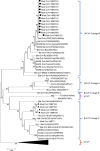Genetic Characteristics of Coronaviruses from Korean Bats in 2016
- PMID: 28725945
- PMCID: PMC7079938
- DOI: 10.1007/s00248-017-1033-8
Genetic Characteristics of Coronaviruses from Korean Bats in 2016
Abstract
Bats have increasingly been recognized as the natural reservoir of severe acute respiratory syndrome (SARS), coronavirus, and other coronaviruses found in mammals. However, little research has been conducted on bat coronaviruses in South Korea. In this study, bat samples (332 oral swabs, 245 fecal samples, 38 urine samples, and 57 bat carcasses) were collected at 33 natural bat habitat sites in South Korea. RT-PCR and sequencing were performed for specific coronavirus genes to identify the bat coronaviruses in different bat samples. Coronaviruses were detected in 2.7% (18/672) of the samples: 13 oral swabs from one species of the family Rhinolophidae, and four fecal samples and one carcass (intestine) from three species of the family Vespertiliodae. To determine the genetic relationships of the 18 sequences obtained in this study and previously known coronaviruses, the nucleotide sequences of a 392-nt region of the RNA-dependent RNA polymerase (RdRp) gene were analyzed phylogenetically. Thirteen sequences belonging to SARS-like betacoronaviruses showed the highest nucleotide identity (97.1-99.7%) with Bat-CoV-JTMC15 reported in China. The other five sequences were most similar to MERS-like betacoronaviruses. Four nucleotide sequences displayed the highest identity (94.1-95.1%) with Bat-CoV-HKU5 from Hong Kong. The one sequence from a carcass showed the highest nucleotide identity (99%) with Bat-CoV-SC2013 from China. These results suggest that careful surveillance of coronaviruses from bats should be continued, because animal and human infections may result from the genetic variants present in bat coronavirus reservoirs.
Keywords: Bats; Coronavirus; Middle East respiratory syndrome; Phylogenetic analysis; Severe acute respiratory syndrome; South Korea.
Figures



Similar articles
-
Diversity of coronavirus in bats from Eastern Thailand.Virol J. 2015 Apr 11;12:57. doi: 10.1186/s12985-015-0289-1. Virol J. 2015. PMID: 25884446 Free PMC article.
-
Detection and characterization of diverse alpha- and betacoronaviruses from bats in China.Virol Sin. 2016 Feb;31(1):69-77. doi: 10.1007/s12250-016-3727-3. Epub 2016 Feb 2. Virol Sin. 2016. PMID: 26847648 Free PMC article.
-
Coronavirus Infection and Diversity in Bats in the Australasian Region.Ecohealth. 2016 Mar;13(1):72-82. doi: 10.1007/s10393-016-1116-x. Epub 2016 Apr 5. Ecohealth. 2016. PMID: 27048154 Free PMC article.
-
Bat Coronaviruses in China.Viruses. 2019 Mar 2;11(3):210. doi: 10.3390/v11030210. Viruses. 2019. PMID: 30832341 Free PMC article. Review.
-
Coronavirus diversity, phylogeny and interspecies jumping.Exp Biol Med (Maywood). 2009 Oct;234(10):1117-27. doi: 10.3181/0903-MR-94. Epub 2009 Jun 22. Exp Biol Med (Maywood). 2009. PMID: 19546349 Review.
Cited by
-
Comparative genetic analyses of Korean bat coronaviruses with SARS-CoV and the newly emerged SARS-CoV-2.J Vet Sci. 2021 Jan;22(1):e12. doi: 10.4142/jvs.2021.22.e12. J Vet Sci. 2021. PMID: 33522164 Free PMC article.
-
Genomic Characterization of a Novel Alphacoronavirus Isolated from Bats, Korea, 2020.Viruses. 2021 Oct 11;13(10):2041. doi: 10.3390/v13102041. Viruses. 2021. PMID: 34696471 Free PMC article.
-
Panoramic analysis of coronaviruses carried by representative bat species in Southern China to better understand the coronavirus sphere.Nat Commun. 2023 Sep 8;14(1):5537. doi: 10.1038/s41467-023-41264-z. Nat Commun. 2023. PMID: 37684236 Free PMC article.
-
Biodiversity loss and COVID-19 pandemic: The role of bats in the origin and the spreading of the disease.Biochem Biophys Res Commun. 2021 Jan 29;538:2-13. doi: 10.1016/j.bbrc.2020.10.028. Epub 2020 Oct 16. Biochem Biophys Res Commun. 2021. PMID: 33092787 Free PMC article.
-
Circulation characteristics of bat coronaviruses linked to bat ecological factors in Korea, 2021-2022.Virulence. 2025 Dec;16(1):2502551. doi: 10.1080/21505594.2025.2502551. Epub 2025 May 12. Virulence. 2025. PMID: 40336345 Free PMC article.
References
-
- Murray PR, Rosenthal KS, Pfaller MA. Medical microbiology. Philadelphia: MOSBY Elsevier; 2009.
MeSH terms
LinkOut - more resources
Full Text Sources
Other Literature Sources
Research Materials
Miscellaneous

